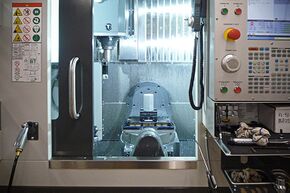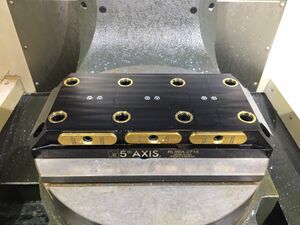Haas UMC-500: Difference between revisions
No edit summary |
|||
| (4 intermediate revisions by the same user not shown) | |||
| Line 4: | Line 4: | ||
{{RestrictedMachine}} | {{RestrictedMachine}} | ||
{{SafetyInfoMissing | {{SafetyInfoMissing}}{{InfoboxEquipment | ||
| description = 5-axis CNC milling machine located in the Morson Engine Room. | | description = 5-axis CNC milling machine located in the Morson Engine Room. | ||
| manufacturer = Haas | | manufacturer = Haas | ||
| Line 13: | Line 13: | ||
}} | }} | ||
The Haas UMC-500 is a | The Haas UMC-500 is a 5-axis milling capable of accurately cutting both ferrous and non-ferrous metals as well as an assortment of plastics and dense modelling foams. It uses a spinning cutting tool such as an endmill or drill to remove material from the parent stock, leaving the finished part at the end. | ||
Typical vertical CNC mills can work in three axes: Z, up and down; X, left to right; and Y, front to back. This 5-axis machine adds two rotary axes, B and C, to allow access to five out of six sides of a cube in one setup - that is without taking the workpiece out and repositioning it in the machine. This allows much faster prototyping and faster turnaround times for one off parts. | |||
== Training == | == Training == | ||
We have produced a series of training parts which will teach you a variety of CAM programming techniques. Follow the instructions on [[Training (Haas UMC-500)|the training page for this machine]], and then book an in-person training session through the online booking form. | We have produced a series of training parts which will teach you a variety of CAM programming techniques. Follow the instructions on [[Training (Haas UMC-500)|the training page for this machine]], and then book an in-person training session through the online booking form. | ||
Once you have completed the first part you are welcome to use the machine independently to complete the remaining components in the set. Once the set is complete, you can use the machine unsupervised. The Maker Space technical staff can assist with any questions you have. | Once you have completed the online tutorial and are ready to cut please complete the [https://forms.office.com/Pages/ResponsePage.aspx?id=QCm1Zbb0vUGDPTAz7Lz24dQpHvOmCP1NlW433yS4JNxUM0M5RklKT0U0REpSMEZWSjVURlUwME5EUCQlQCN0PWcu training request form]. | ||
After you have completed the first part you are welcome to use the machine independently to complete the remaining components in the set. Once the set is complete, you can use the machine unsupervised. The Maker Space technical staff can assist with any questions you have. | |||
== Power Up & Power Down == | == Power Up & Power Down == | ||
[[Power Up | [[Power Up and Power Down (Haas UMC-500)]] | ||
You must warm up the spindle bearings if the machine has not been used in the last 24 hours. This is to ensure they are properly lubricated and ready for high loads. | You must warm up the spindle bearings if the machine has not been used in the last 24 hours. This is to ensure they are properly lubricated and ready for high loads. | ||
== | == Usage Information == | ||
== Workholding == | === [[Workholding (Haas UMC-500)|Workholding]] === | ||
[[File:Rocklock-base.jpg|thumb|5th Axis Rocklock base mounted to UMC-500 table.]] | [[File:Rocklock-base.jpg|thumb|5th Axis Rocklock base mounted to UMC-500 table.]] | ||
There is a range of workholding solutions available for you to use, all centering around the quick-change 5th Axis Rocklock Base. This base uses pull studs on a 96mm square pattern to allow rapid workholding changes. It is possible to machine your own fixtures using the 96mm pattern and the proprietary pull studs. | There is a range of workholding solutions available for you to use, all centering around the quick-change 5th Axis Rocklock Base. This base uses pull studs on a 96mm square pattern to allow rapid workholding changes. It is possible to machine your own fixtures using the 96mm pattern and the proprietary pull studs. | ||
=== [[Tool Library (Haas UMC-500)|Tool Library]] === | |||
We try to provide a standard set of tools ready to use in the machine. These tools are found in the Fusion 360 tool library, and are kept set up in their tool holders either in the machine or in the tool cabinet. | |||
== | The [[Toolholders (Haas UMC-500)|toolholders]] used to hold the cutting tools are also somewhat standard, with noted exceptions for special use tools. | ||
=== [[Haas WIPS Probe|WIPS Probe/Work Offset Probe]] === | |||
The work probe, work offset probe, or WIPS probe is used to precisely locate parts in the machine and measure features to ensure accuracy. The probe is a tool that is mounted in the spindle, and is known to the machine as Tool Number 199. | |||
=== [[Tool Setter (Haas UMC-500)|Tool Probe/Tool Setter]] === | |||
Mounted on a post in the machine enclosure, the tool probe measures the length and diameter of tools that are in the spindle. Use the tool setter every time a cutting tool is replaced or introduced into the machine to ensure accuracy. Be careful, the sensor tip is sensitive and can easily be snapped if you are careless when moving around inside the machine enclosure. | |||
=== Out-of-hours operation === | |||
If you wish to run this machine out of hours (overnight or on a weekend) you need to [[Compressed Air|request compressed air]] from the building manager. | |||
=== [[Troubleshooting (Haas UMC-500)|Troubleshooting]] === | |||
A few issues come up over and over - take a look here to see if your problem has a known solution. | |||
Latest revision as of 18:05, 10 January 2024
 | |
| 5-axis CNC milling machine located in the Morson Engine Room. | |
| Equipment Information | |
|---|---|
| Status | Unknown |
| Manufacturer | Haas |
| Model | UMC-500 |
| Working Area | 400 mm ⌀ x 250mm |
| Maker Space Information | |
| Training Required | Yes |
| Training Information | Here |
The Haas UMC-500 is a 5-axis milling capable of accurately cutting both ferrous and non-ferrous metals as well as an assortment of plastics and dense modelling foams. It uses a spinning cutting tool such as an endmill or drill to remove material from the parent stock, leaving the finished part at the end.
Typical vertical CNC mills can work in three axes: Z, up and down; X, left to right; and Y, front to back. This 5-axis machine adds two rotary axes, B and C, to allow access to five out of six sides of a cube in one setup - that is without taking the workpiece out and repositioning it in the machine. This allows much faster prototyping and faster turnaround times for one off parts.
Training
We have produced a series of training parts which will teach you a variety of CAM programming techniques. Follow the instructions on the training page for this machine, and then book an in-person training session through the online booking form.
Once you have completed the online tutorial and are ready to cut please complete the training request form.
After you have completed the first part you are welcome to use the machine independently to complete the remaining components in the set. Once the set is complete, you can use the machine unsupervised. The Maker Space technical staff can assist with any questions you have.
Power Up & Power Down
Power Up and Power Down (Haas UMC-500)
You must warm up the spindle bearings if the machine has not been used in the last 24 hours. This is to ensure they are properly lubricated and ready for high loads.
Usage Information
Workholding

There is a range of workholding solutions available for you to use, all centering around the quick-change 5th Axis Rocklock Base. This base uses pull studs on a 96mm square pattern to allow rapid workholding changes. It is possible to machine your own fixtures using the 96mm pattern and the proprietary pull studs.
Tool Library
We try to provide a standard set of tools ready to use in the machine. These tools are found in the Fusion 360 tool library, and are kept set up in their tool holders either in the machine or in the tool cabinet.
The toolholders used to hold the cutting tools are also somewhat standard, with noted exceptions for special use tools.
WIPS Probe/Work Offset Probe
The work probe, work offset probe, or WIPS probe is used to precisely locate parts in the machine and measure features to ensure accuracy. The probe is a tool that is mounted in the spindle, and is known to the machine as Tool Number 199.
Tool Probe/Tool Setter
Mounted on a post in the machine enclosure, the tool probe measures the length and diameter of tools that are in the spindle. Use the tool setter every time a cutting tool is replaced or introduced into the machine to ensure accuracy. Be careful, the sensor tip is sensitive and can easily be snapped if you are careless when moving around inside the machine enclosure.
Out-of-hours operation
If you wish to run this machine out of hours (overnight or on a weekend) you need to request compressed air from the building manager.
Troubleshooting
A few issues come up over and over - take a look here to see if your problem has a known solution.

